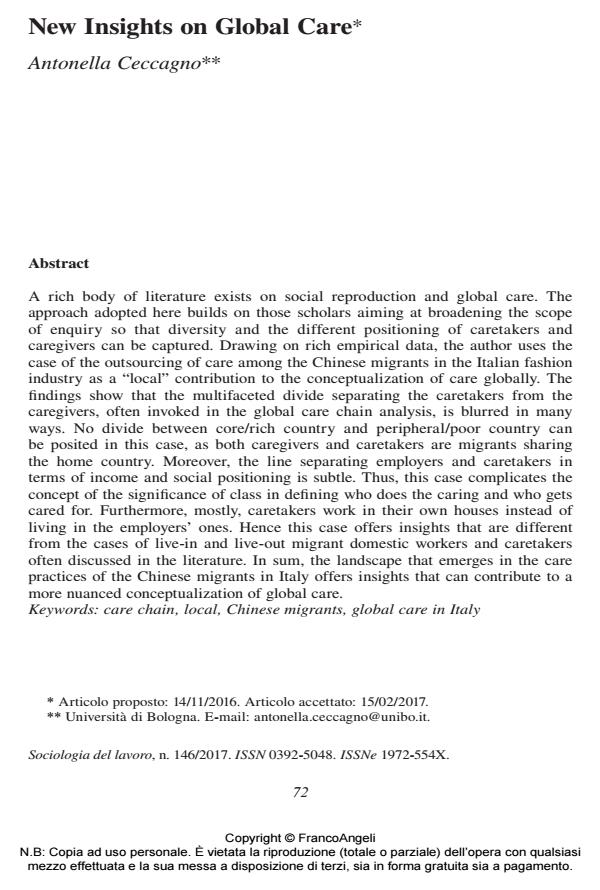New Insights on Global Care
Journal title SOCIOLOGIA DEL LAVORO
Author/s Antonella Ceccagno
Publishing Year 2017 Issue 2017/146
Language English Pages 17 P. 72-88 File size 107 KB
DOI 10.3280/SL2017-146005
DOI is like a bar code for intellectual property: to have more infomation
click here
Below, you can see the article first page
If you want to buy this article in PDF format, you can do it, following the instructions to buy download credits

FrancoAngeli is member of Publishers International Linking Association, Inc (PILA), a not-for-profit association which run the CrossRef service enabling links to and from online scholarly content.
A rich body of literature exists on social reproduction and global care. The approach adopted here builds on those scholars aiming at broadening the scope of enquiry so that diversity and the different positioning of caretakers and caregivers can be captured. Drawing on rich empirical data, the author uses the case of the outsourcing of care among the Chinese migrants in the Italian fashion industry as a "local" contribution to the conceptualization of care globally. The findings show that the multifaceted divide separating the caretakers from the caregivers, often invoked in the global care chain analysis, is blurred in many ways. No divide between core/rich country and peripheral/poor country can be posited in this case, as both caregivers and caretakers are migrants sharing the home country. Moreover, the line separating employers and caretakers in terms of income and social positioning is subtle. Thus, this case complicates the concept of the significance of class in defining who does the caring and who gets cared for. Furthermore, mostly, caretakers work in their own houses instead of living in the employers’ ones. Hence this case offers insights that are different from the cases of live-in and live-out migrant domestic workers and caretakers often discussed in the literature. In sum, the landscape that emerges in the care practices of the Chinese migrants in Italy offers insights that can contribute to a more nuanced conceptualization of global care.
Keywords: Care chain, local, Chinese migrants, global care in Italy
- City Making and Global Labor Regimes Antonella Ceccagno, pp.183 (ISBN:978-3-319-59980-9)
- The mobility of workers living at work in Europe Antonella Ceccagno, Devi Sacchetto, in Current Sociology /2020 pp.299
DOI: 10.1177/0011392119863831 - City Making and Global Labor Regimes Antonella Ceccagno, pp.257 (ISBN:978-3-319-59980-9)
Antonella Ceccagno, New Insights on Global Care in "SOCIOLOGIA DEL LAVORO " 146/2017, pp 72-88, DOI: 10.3280/SL2017-146005